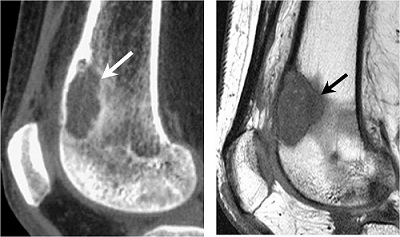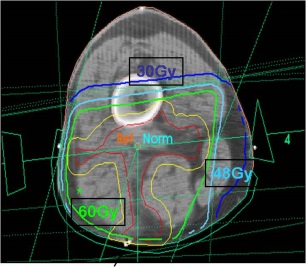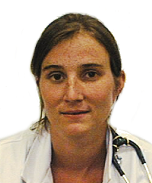Sarcomas or Cancer of the musculoskeletal system

Overview/Epidemiology
Sarcomas are cancers that develop from the bones and supporting tissues. The latter include, among others, the muscles, cartilage, fat, blood vessels, etc.
Sarcomas are rare (1% of all cancers) and can also affect pediatric patients. The diagnostic approach to them is complex, mainly due to the great variety of locations and types of cancers. Sarcomas constitute in fact a very heterogeneous group of cancers. Their treatment is highly specific and requires the experience of specialists in diagnosis (radiologists, pathologists, geneticists, etc.) and treatment (surgeons, radiotherapists and medical oncologists) who arrange multidisciplinary meetings to determine the treatment best suited to the patient and most consistent with the most recent scientific data.
The heterogeneity of sarcomas and their infrequent occurrence mean that the number of teams that have acquired the experience required to treat them optimally remains limited.
Over one hundred sarcomas are treated annually at the Institut Roi Albert II of the Cliniques Universitaires Saint-Luc. This represents approximately 1/5 of the sarcomas treated in Belgium.
Osseous sarcomas (chondrosarcoma, osteosarcoma, etc.), soft tissue sarcomas (leiomyosarcoma, liposarcoma, etc.) and retroperitoneal sarcomas are generally distinguished. In one out of five cases, a mass of over 5 cm proves to be a sarcoma.
Risk factors
The causes of sarcomas are poorly understood. There is a genetic influence in some cases.
Some mutations are investigated during the diagnosis because they give rise to a predisposition to the appearance of these cancers.
Symptoms
Sarcomas often occur in the form of a mass, a "lump" that increases in volume. This mass can appear anywhere in the body. Osseous sarcomas can lead to persistent pain. Their presence is revealed by the x-ray taken to detect the origin of the pain. More rarely, a pathological fracture can reveal a bone sarcoma.
Pain is more rarely a warning sign for the other types of sarcomas. In this case, they can appear as a swelling or a troublesome deformity. Abnormal soft tissue masses can be identified by ultrasound for superficial locations, and primarily by magnetic resonance for deep locations.
Diagnosis
 Imaging, a microscopic examination and a genetic analysis guide the therapeutic strategy. The strategy to be followed in treatment is also very intricate. Thus, it is generally necessary to confirm the diagnosis by a biopsy, collection of a sample of the abnormal tissue for examination under the microscope. This also allows the type of sarcoma to be specified and so provides guidance for treatment. The biopsy should ideally be performed by the team that will treat the sarcoma. In fact, a poorly done or poorly positioned biopsy can seriously compromise the patient’s chances of recovery. A very precise and very rigorous evaluation of the extent of the tumor by imaging techniques (conventional radiology, magnetic resonance imaging, etc.) furthermore allows the mass to be precisely identified and located in relation to the anatomical landmarks, and allows a too-drastic surgical procedure to be avoided. This mapping of the tumor is essential to the staging, and the planning of treatment.
Imaging, a microscopic examination and a genetic analysis guide the therapeutic strategy. The strategy to be followed in treatment is also very intricate. Thus, it is generally necessary to confirm the diagnosis by a biopsy, collection of a sample of the abnormal tissue for examination under the microscope. This also allows the type of sarcoma to be specified and so provides guidance for treatment. The biopsy should ideally be performed by the team that will treat the sarcoma. In fact, a poorly done or poorly positioned biopsy can seriously compromise the patient’s chances of recovery. A very precise and very rigorous evaluation of the extent of the tumor by imaging techniques (conventional radiology, magnetic resonance imaging, etc.) furthermore allows the mass to be precisely identified and located in relation to the anatomical landmarks, and allows a too-drastic surgical procedure to be avoided. This mapping of the tumor is essential to the staging, and the planning of treatment.
Finally, identification of the genetic characteristics of sarcomas proves to be highly useful. It contributes to better specifying the type of disorder and allows the behavior of the tumor to be determined in order to adapt the therapeutic approach to it. Genetic analysis is also useful in evaluating the risk of development of a cancer in descendants.
Examination of a sample of the tumor under the microscope and staging established by imaging are essential to avoid any risk of an inadequate or too drastic surgical procedure.
Identification of the genetic characteristics of some sarcomas allows their progression to be predicted and the treatment to be refined.
.
Reviews
Imaging of bone lesions suspected of being sarcomas starts with simple x-rays. If this suspicion is confirmed, the subsequent workup will include a CT scan and an MRI in most situations. The stage must also be determined.
For soft tissue masses, while ultrasound allows the assessment to be begun, the standard imaging remains magnetic resonance.
Treatments
Treatment of sarcomas is intrinsically multidisciplinary and multimodal. It can make use of various types of treatments, alone or in combination.
Highly specific surgery
Surgery constitutes the cornerstone in treatment of sarcomas. This surgery is performed by teams specifically trained in this treatment, and depending on the complexity of the procedure to be performed, several surgical teams may be involved. Sarcomas may be treated by different surgeons depending on the location of the tumor. For example, a retroperitoneal liposarcoma will be treated by our gastrointestinal surgeons, while an osteosarcoma of the femur will be treated by our orthopedic surgeons, and our plastic surgeons will be enlisted for other locations.
The surgical procedures performed to treat sarcomas are relatively complex, since they combine removal of the cancer and preservation of the function of the organs or limbs, sometimes with reconstruction. This is especially true in treatment of a tumor affecting a limb, where this reconstruction can involve bone grafts, joint prostheses or a combination of the two. This advanced approach contributes to best preserving the function of the limb.
In this regard, the latest imaging techniques allow the graft in the tissue bank to be chosen that will be best suited to the reconstruction.
The progress made in the treatment of sarcomas has considerably reduced the number of amputations; they are necessary only in less than 5% of cases
Radiotherapy and chemotherapy
 Radiotherapy will be indicated depending on the type of surgery and the size, location, type and grade of the tumor. Radiotherapy is often planned in addition to the surgical procedure, but may sometimes precede the surgery. It then allows a less drastic procedure to be performed while ensuring an equivalent local control rate. Chemotherapy is also among the therapeutic tools. It is the basic treatment for pediatric tumors. In adults, chemotherapy is instead reserved for certain specific types of tumors or more advanced stages. In some cases, it is however necessary to administer chemotherapy before the procedure to facilitate the surgical removal of the tumor. This chemotherapy cycle also allows the sensitivity of the sarcoma to chemotherapy to be determined and taken into account in elaboration of the treatment that follows the surgery. New treatments are constantly being evaluated in the international studies in which the Institut Roi Albert II is an active participant.
Radiotherapy will be indicated depending on the type of surgery and the size, location, type and grade of the tumor. Radiotherapy is often planned in addition to the surgical procedure, but may sometimes precede the surgery. It then allows a less drastic procedure to be performed while ensuring an equivalent local control rate. Chemotherapy is also among the therapeutic tools. It is the basic treatment for pediatric tumors. In adults, chemotherapy is instead reserved for certain specific types of tumors or more advanced stages. In some cases, it is however necessary to administer chemotherapy before the procedure to facilitate the surgical removal of the tumor. This chemotherapy cycle also allows the sensitivity of the sarcoma to chemotherapy to be determined and taken into account in elaboration of the treatment that follows the surgery. New treatments are constantly being evaluated in the international studies in which the Institut Roi Albert II is an active participant.
Research/Innovation
The progress made in the treatment of sarcomas is thus multifaceted. It is reflected in refinement in the diagnostic approach, better assessment of the behavior of the tumor, more efficient surgical techniques and optimization of complementary treatments such as radiotherapy and chemotherapy. This progress is ongoing thanks to the involvement of the Université Catholique de Louvain, the Cliniques Universitaires Saint-Luc and the IRA II in research and international oncological protocols.
Contact
For any further information, or if you would like to make an appointment, please contact the Oncology Care Coordinator for Sacomas at + 32 2 764 90 03.
Doctor

Pr Xavier BANSE

Pr Bénédicte BRICHARD

Dr Laurent COUBEAU
Dr Julien COULIE

Pr Anne DE LEENER

Pr An-Katrien DE ROO

Pr Maëlle de VILLE de GOYET

Pr Pierre-Louis DOCQUIER

Dr Dana DUMITRIU

Pr Christine GALANT

Pr Xavier GEETS
Dr Jennifer HAMMER

Pr Thomas KIRCHGESNER

Pr Valérie LACROIX
Dr Manon LE ROUX

Pr Fréderic E. LECOUVET

Pr Benoît LENGELÉ

Dr Filomena MAZZEO
Dr Barbara SCHMIDT

Pr Thomas SCHUBERT
Dr Lokmane TAIHI

Dr Sandy VAN NIEUWENHOVE
Paramedical
Victorine DETRAUX

Sabine DEVAUX

Charlotte GOEMAERE

Kim HENQUIN

